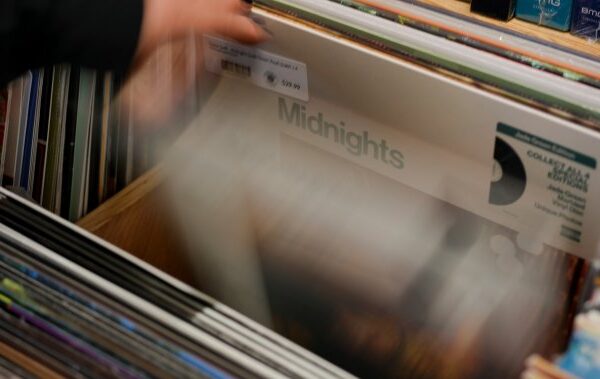
Have we entered a new analog era? Generation Z is taking us there – National
We first heard about the brave new world of “digital” in the late 1970s. We didn’t really know what that meant, but it seemed futuristic and cool, especially with music. It held the promise of greater precision and fidelity that we could convey to our monster stereo systems. Ry Cooder made history as the first artist to release a digitally recorded album with Bop until you drop in 1979. The CD arrived a few years later, contributing to the digital boom. Soon, all recording studios began migrating from their giant analog tape recorders and consoles to cutting-edge hard drive systems powered by software like Pro Tools. In the late 90s, everything was digital: CDs, MP3s, personal music devices, etc. Beyond a few outliers who wouldn’t give up, I think of you, Jack White, Lenny Kravitz and all those who refused to give up vinyl albums – analog music was essentially dead. Story continues below advertisement Of course, everything is different now. Even though streaming is the dominant form of music consumption, analog is still very present. Artists looking for a special recording feel seek out studios still equipped with old two-inch, 24-track tape machines. Vinyl sales have been on an upward trajectory since 2008. Even cassettes refuse to disappear. Learn more about entertainment More videos But this thirst for analog runs deeper and largely belongs to Generation Z. The first generation to grow up in an always-on, always-connected digital world is looking for something more tangible. They express nostalgia for a time before their birth. Many late-millennials and Generation Z (and arguably the newest cohort, Generation Alpha) seem to have a soft spot for the times before, a time when things were less complicated, more orderly , less divided and had more substance, and a time when everyone wasn’t glued to their devices 24/7. Today, these generations only see crazy policies, eternal wars, climate crisisan unbalanced economic system, a deluge of misinformation, and a social media ecosystem – something that is used by half of all humans on the planet – that aims to make them feel inadequate. Now they face a few AI. Receive national news daily Get the day’s top news, politics, business and current affairs headlines delivered to your inbox once a day. In other words, they want to imagine the good old days. Young people feel stressed, hopeless, scared and alone. Gen Z’s interest in things they can touch, hold, and physically own helps them find stability in a turbulent world. Story continues below advertisement When it comes to music, I see a lot of anecdotal evidence. Young people have fallen in love with vinyl and are buying as much as they can afford. Ask any independent record store what they buy and they’ll tell you it’s the classics: The Beatles, Led Zeppelin, Pink Floyd. Any used copy of Fleetwood Mac’s Rumors what arrives is sold in seconds. At concerts, it’s the first thing people look for. A lot of these young vinyl collectors don’t have a turntable because they don’t need one. They can lie in bed and examine their newly purchased physical album for its artwork, liner notes, and lyrics while streaming it. From that point of view, it’s the best of both worlds. It also provides a break from screens. Some have also given up listening with headphones because they can feel disconnected. CD sales continue to decline, but the rate of decline may slow as Generation Z embraces this format as well. To them, the CD is as old as a vinyl record or a cassette, but it is a real-world object. This is both new and reassuring. And physical representations of music have given rise to a new type of fandom, status, and expression of identity. “I’m willing to spend SO MUCH on things like records and CDs to prove that I’m a huge music fan! I have five feet of shelves to display my music collection! Try doing this with Spotify or a hard drive full of digital files. Artists responded to this trend, led by Taylor Swift and his endless release of multiple vinyl versions. Physical editions help fuel fandom and superfandom. The Weeknd, Billie Eilish and Sabrina Carpenter know it too. Story continues below advertisement 0:47 Demand for all things Taylor Swift boosts business at Saskatoon record store I spoke at a high school earlier this month in front of about 300 students, many of whom wore T-shirts emblazoned with the logos of ’90s bands: Nirvana, Rush, Metallica, The Hip, and more bands specialized as Suicidal Tendencies. . Such a retro product far surpassed that of any current artist. When I asked a few of them about their favorite era of music, most of them cited the 90s. I also spotted more than one student brandishing a flip phone. This desire for featureless phones has caught the industry’s attention. Earlier this year, The boring phone was released and was so successful that a second version is coming soon. “Tired of being controlled by your phone? It’s time for a change. Introducing BP2 (Boring Phone 2) – the next generation of technology that respects your time and attention. They could also have added: “We will not collect your personal data in order to sell it. » Story continues below advertisement It’s not just about phones. Have you noticed that standalone cameras are making a comeback thanks to Generation Z? Not just film cameras either; even the Polaroid camera is a thing again. The resulting somewhat grainy and often imperfect photos are valued for their realism and authenticity. This needs to be paid attention to as the market is still following the trends of the younger generation of consumers. Brands know they need to tap into retro trends if they want to authentically connect with Gen Z. Where the kids go, there we all go. What’s next? A reversal of fortune for print magazines? A helping hand for bookstores? A return to big stereo systems in the rooms? Don’t…





















